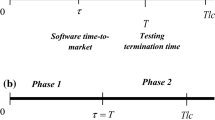Abstract
Quality of software system generally depends on how much time testing takes and what testing methodologies are used. One attribute of quality is reliability which can be increased by removing more faults from the software and this can be done by spending more time on testing. However, spending more time on testing will increase cost of the software development process. On the other hand, if testing time is too short, testing cost of software may be reduced but it will increase the chance of getting unreliable software and customers may not take higher risk of buying unreliable software. Highly competitive market conditions have forced developers to offer highly reliable products to the users. Software warranty is one such indicator used by the users to judge its reliability with the perception that a longer warranty period indicates higher reliability. Software warranty is a tool which provides assurance about the quality. Warranty cost may be reduced by providing more reliable product. Therefore software reliability, testing, warranty period and cost needs to be considered jointly. In this paper, we propose a new method to estimate the optimal software release time of a software with warranty under imperfect debugging environment by using Multi Attribute Utility Theory. More precisely, three significant attributes, namely Reliability, Cost and Detection rate indicator are used to determine the optimal release time of software under warranty. The proposed new decision model based on multi-attribute utility analysis is tested on the real world data set.


Similar content being viewed by others
References
Brown DB, Maghsoodloo S, Deason WH (1989) A cost model for determining the optimal number of test cases. IEEE Trans Softw Eng 15(2):218–221
Fishburn CP (1970) Utility theory for decision making. Wiley, New York
Goel AL, Okumoto K (1979) Time-dependent error-detection rate model for software reliability and other performance measures. IEEE Trans Reliab 28:206–211
Kapur PK, Garg RB (1990a) Cost reliability optimum release policies for a software system with testing effort. Oper Res 27:109–116
Kapur PK, Garg RB (1990b) Optimal software release policies for software reliability growth model under imperfect debugging. RAIRO 24:295–305
Kapur PK, Garg RB (1990c) Optimal release policies for software systems with testing effort. Int J Syst Sci 22(9):1563–1571
Kapur PK, Garg RB (1992) A software reliability growth model for an error-removal phenomenon. Softw Eng J 7:291–294
Kapur PK, Agarwala S, Garg RB (1994) Bicriterion release policy for exponential software reliability growth model. Oper Res 28:165–180
Kapur PK, Kumar D, Gupta A, Jha PC (2006) On how to model software reliability growth in the presence of imperfect debugging and error generation, Proceedings of 2nd international conference on reliability and safety engineering, pp 515–523
Kapur PK, Gupta D, Gupta A, Jha PC (2007) Effect of introduction of faults and imperfect debugging on release time. Ratio Mathematica 18:62–90
Kapur PK, Tondon A, Kaur G (2010) Multi up-gradation software reliability model, 2nd international conference on reliability, safety & hazard (ICRESH-2010), Mumbai, pp 468–474
Kapur PK, Pham H, Gupta A, Jha PC (2011) Software reliability assessment with OR applications. Springer, London
Kapur PK, Pham H, Aggarwal AG, Kaur G (2012) Two-dimensional multi-release software reliability modelling and optimal release planning. IEEE Trans Reliab 61(3):758–768
Kapur PK, Singh VB, Singh O, Singh JNP (2013) Software release time based on different multi-attribute utility functions. Int J Reliab 20(4):1350012
Keeney RL, Raiffa H (1976) Decisions with multiple objectives: preferences and value tradeoffs. Wiley, New York
Li X, Li YF, Xie M, Ng SH (2011) Reliability analysis and optimal version-updating for open source software. Inform Softw Technol 53:929–936
Musa JD, Iannino A, Okumoto K (1987) Software reliability: measurement, prediction, applications. Mc Graw Hill, New York
Ohba M, Chou XM (1989) Does imperfect debugging effect software reliability growth, Proceedings of 11th international conference of software engineering, pp 237–244
Ohtera H, Yamada S (1990) Optimum software-release time considering an error detection phenomenon during operation. IEEE Trans Reliab 39(5):596–599
Okumoto K, Goel AL (1983) Optimal release time for computer software. IEEE Trans Softw Eng 9:323–327
Pham H (2006) System software reliability. Springer, London
Pham H, Zhang X (1999a) Software release policies with gain in reliability justifying costs. Annals Softw Eng 8:1–4
Pham H, Zhang X (1999b) A software cost model with warranty and risk costs. IEEE Trans Comput 48(1):71–75
Pressman RS (1997) Software engineering: a practitioner’s approach. McGraw Hill, New York
Ross SM (1985) Software reliability: the stopping rule problem. IEEE Trans Softw Eng 11(12):1472–1476
Web reference, http://wiki.ece.cmu.edu/ddl/index.php/Multiattribute_utility_theory. Accessed 23 Dec 2012
Wood A (1996) Predicting software reliability. IEEE Comput 9:69–77
Yamada S (1994) Optimal release problems with warranty period based on a software maintenance cost model. Trans IPS Jpn 35(9):2197–2202
Yamada S, Obha M, Osaki S (1983) S-shaped software reliability growth modelling for software error detection. IEEE Trans Reliab 32(5):475–484
Yamada S, Ohba M, Osaki S (1984a) S-shaped software reliability growth models and their applications. IEEE Trans Reliab 33(4):289–292
Yamada S, Narihisa H, Osaki S (1984b) Optimum release policies for a software system with a scheduled software delivery time. Int J Syst Sci 15(8):905–914
Zhang X, Teng X, Pham H (2003) Considering fault removal efficiency in software reliability assessment. IEEE Trans Syst Man Cybern Part A 33(1):114–120
Author information
Authors and Affiliations
Corresponding author
Rights and permissions
About this article
Cite this article
Singh, O., Kapur, P.K., Shrivastava, A.K. et al. Release time problem with multiple constraints. Int J Syst Assur Eng Manag 6, 83–91 (2015). https://doi.org/10.1007/s13198-014-0246-1
Received:
Published:
Issue Date:
DOI: https://doi.org/10.1007/s13198-014-0246-1




